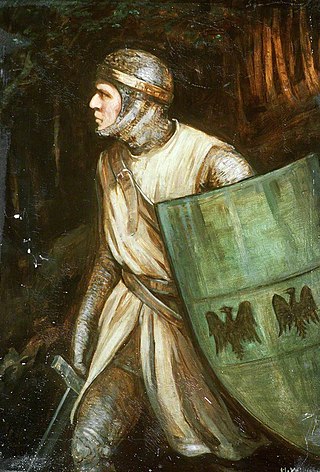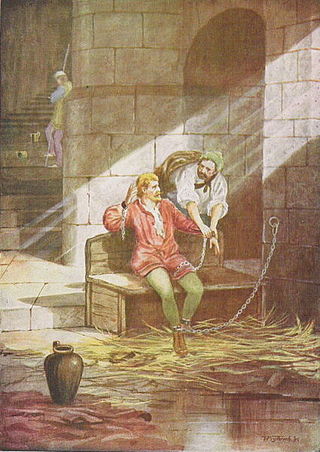The 1080s was a decade of the Julian Calendar which began on January 1, 1080, and ended on December 31, 1089.
Year 1118 (MCXVIII) was a common year starting on Tuesday of the Julian calendar.

Year 1137 (MCXXXVII) was a common year starting on Friday of the Julian calendar.

Year 19 was a common year starting on Saturday of the Julian calendar.

Owain ap Gruffudd was King of Gwynedd, North Wales, from 1137 until his death in 1170, succeeding his father Gruffudd ap Cynan. He was called Owain the Great and the first to be styled "Prince of Wales" and the "Prince of the Welsh". He is considered to be the most successful of all the North Welsh princes prior to his grandson, Llywelyn ab Iorwerth. He became known as Owain Gwynedd to distinguish him from the contemporary king of Powys Wenwynwyn, Owain ap Gruffydd ap Maredudd, who became known as Owain Cyfeiliog.

Gruffudd ap Cynan was King of Gwynedd from 1081 until his death in 1137. In the course of a long and eventful life, he became a key figure in Welsh resistance to Norman rule.

The Battle of Dyrrhachium took place on October 18, 1081 between the Byzantine Empire, led by the Emperor Alexios I Komnenos, and the Normans of southern Italy under Robert Guiscard, Duke of Apulia and Calabria. The battle was fought outside the city of Dyrrhachium, the major Byzantine stronghold in the western Balkans, and ended in a Norman victory.

Rhys ap Tewdwr was a king of Deheubarth in Wales and member of the Dinefwr dynasty, a branch descended from Rhodri the Great. Following the Norman Conquest, he had to pay William the Conqueror to keep his kingdom, which lasted until the end of William's reign.
Trahaearn ap Caradog (1044–1081) was a King of Gwynedd. Trahaearn was a son of Caradog ap Gwyn, ruler of Arwystli, a small state, on the south-western border between Gwynedd and Powys. He was born in 1044 in Arwystli, and died in 1081 in Mynydd Carn in Pembrokeshire, at the Battle of Mynydd Carn.

Bleddyn ap Cynfyn, sometimes spelled Blethyn, was an 11th century Welsh king. King Harold Godwinson and Tostig Godwinson installed Bleddyn and his brother, Rhiwallon, as the co-rulers of kingdom of Gwynedd on his father's death in 1063, during their destruction of the kingdom of their half-brother, king Gruffydd ap Llywelyn. Bleddyn became king of Powys and co-ruler of the Kingdom of Gwynedd with his brother Rhiwallon from 1063 to 1075. His descendants continued to rule Powys as the House of Mathrafal.
The Battle of Mynydd Carn took place in 1081, as part of a dynastic struggle for control of the Welsh kingdoms of Gwynedd and Deheubarth. The result of the battle had a radical effect on the history of Wales.
Caradog ap Gruffydd was a Prince of Gwent in south-east Wales in the time of Gruffydd ap Llywelyn and the Norman conquest, who reunified his family's inheritance of Morgannwg and made repeated attempts to reunite southern Wales by claiming the inheritance of the Kingdom of Deheubarth.

Robert of Rhuddlan was a Norman adventurer who became lord of much of north-east Wales and for a period lord of all North Wales.

Cadwgan ap Bleddyn (1051–1111) was a prince of the Kingdom of Powys in north eastern Wales. He was the second son of Bleddyn ap Cynfyn who was king of both Kingdom of Powys and Gwynedd.
This article is about the particular significance of the century 1001–1100 to Wales and its people.

Wales in the High Middle Ages covers the 11th to 13th centuries in Welsh history. Beginning shortly before the Norman invasion of the 1060s and ending with the Conquest of Wales by Edward I between 1278 and 1283, it was a period of significant political, cultural and social change for the country.

The history of Gwynedd in the High Middle Ages is a period in the History of Wales spanning the 11th through the 13th centuries. Gwynedd, located in the north of Wales, eventually became the most dominant of Welsh polities during this period. Contact with continental courts allowed for Gwynedd to transition from a petty kingdom into an increasingly sophisticated principality of seasoned courtiers capable of high level deplomacy and representation; not only with the Angevine kings, but also the king of France and the Papal See. Distinctive achievements in Gwynedd include further development of Medieval Welsh literature, particularly poets known as the Beirdd y Tywysogion associated with the court of Gwynedd; the reformation of bardic schools; and the continued development of Cyfraith Hywel. All three of these further contributed to the development of a Welsh national identity in the face of Anglo-Norman encroachment of Wales.

The Theme of Dyrrhachium or Dyrrhachion was a Byzantine military-civilian province (theme), covering the Adriatic coast of modern Albania, and some coastal regions of modern Montenegro. It was established in the early 9th century and named after its capital, Dyrrhachium.












